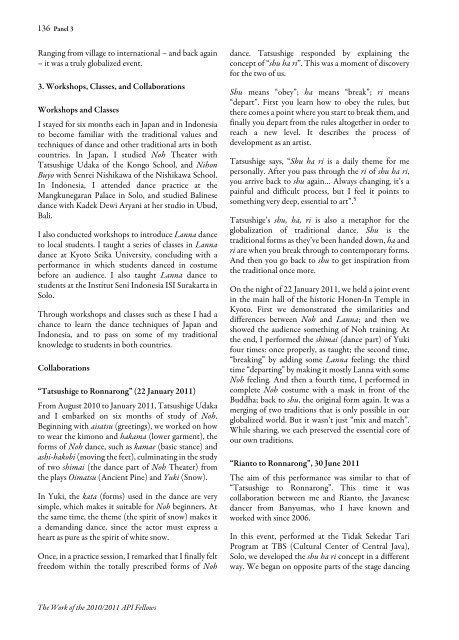Untitled - Api-fellowships.org
Untitled - Api-fellowships.org
Untitled - Api-fellowships.org
You also want an ePaper? Increase the reach of your titles
YUMPU automatically turns print PDFs into web optimized ePapers that Google loves.
136 Panel 3Ranging from village to international – and back again– it was a truly globalized event.3. Workshops, Classes, and CollaborationsWorkshops and ClassesI stayed for six months each in Japan and in Indonesiato become familiar with the traditional values andtechniques of dance and other traditional arts in bothcountries. In Japan, I studied Noh Theater withTatsushige Udaka of the Kongo School, and NihonBuyo with Senrei Nishikawa of the Nishikawa School.In Indonesia, I attended dance practice at theMangkunegaran Palace in Solo, and studied Balinesedance with Kadek Dewi Aryani at her studio in Ubud,Bali.I also conducted workshops to introduce Lanna danceto local students. I taught a series of classes in Lannadance at Kyoto Seika University, concluding with aperformance in which students danced in costumebefore an audience. I also taught Lanna dance tostudents at the Institut Seni Indonesia ISI Surakarta inSolo.Through workshops and classes such as these I had achance to learn the dance techniques of Japan andIndonesia, and to pass on some of my traditionalknowledge to students in both countries.Collaborations“Tatsushige to Ronnarong” (22 January 2011)From August 2010 to January 2011, Tatsushige Udakaand I embarked on six months of study of Noh.Beginning with aisatsu (greetings), we worked on howto wear the kimono and hakama (lower garment), theforms of Noh dance, such as kamae (basic stance) andashi-hakobi (moving the feet), culminating in the studyof two shimai (the dance part of Noh Theater) fromthe plays Oimatsu (Ancient Pine) and Yuki (Snow).In Yuki, the kata (forms) used in the dance are verysimple, which makes it suitable for Noh beginners. Atthe same time, the theme (the spirit of snow) makes ita demanding dance, since the actor must express aheart as pure as the spirit of white snow.Once, in a practice session, I remarked that I finally feltfreedom within the totally prescribed forms of Nohdance. Tatsushige responded by explaining theconcept of “shu ha ri”. This was a moment of discoveryfor the two of us.Shu means “obey”; ha means “break”; ri means“depart”. First you learn how to obey the rules, butthere comes a point where you start to break them, andfinally you depart from the rules altogether in order toreach a new level. It describes the process ofdevelopment as an artist.Tatsushige says, “Shu ha ri is a daily theme for mepersonally. After you pass through the ri of shu ha ri,you arrive back to shu again… Always changing, it’s apainful and difficult process, but I feel it points tosomething very deep, essential to art”. 5Tatsushige’s shu, ha, ri is also a metaphor for theglobalization of traditional dance. Shu is thetraditional forms as they’ve been handed down, ha andri are when you break through to contemporary forms.And then you go back to shu to get inspiration fromthe traditional once more.On the night of 22 January 2011, we held a joint eventin the main hall of the historic Honen-In Temple inKyoto. First we demonstrated the similarities anddifferences between Noh and Lanna; and then weshowed the audience something of Noh training. Atthe end, I performed the shimai (dance part) of Yukifour times: once properly, as taught; the second time,“breaking” by adding some Lanna feeling; the thirdtime “departing” by making it mostly Lanna with someNoh feeling. And then a fourth time, I performed incomplete Noh costume with a mask in front of theBuddha; back to shu, the original form again. It was amerging of two traditions that is only possible in ourglobalized world. But it wasn’t just “mix and match”.While sharing, we each preserved the essential core ofour own traditions.“Rianto to Ronnarong”, 30 June 2011The aim of this performance was similar to that of“Tatsushige to Ronnarong”. This time it wascollaboration between me and Rianto, the Javanesedancer from Banyumas, who I have known andworked with since 2006.In this event, performed at the Tidak Sekedar TariProgram at TBS (Cultural Center of Central Java),Solo, we developed the shu ha ri concept in a differentway. We began on opposite parts of the stage dancingThe Work of the 2010/2011 API Fellows
















